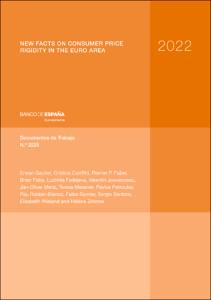New facts on consumer price rigidity in the euro area
Autor
Gautier, Erwan; Conflitti, Cristina; Faber, Riemer P.; Fabo, Brian; Fadejeva, Ludmila; Jouvanceau, Valentin; Menz, Jan-Oliver; Messner, Teresa; Petroulas, Pavlos; Roldán Blanco, Pau; Rumler, Fabio; Santoro, Sergio; Wieland, Elisabeth; Zimmer, Hélène
Fecha de publicación
11-jul-2022
Descripción física
109 p.
Resumen
Usando microdatos del IPC para 11 países del área del euro, que representan el 60 % de la cesta europea de consumo durante el período 2010-2019, documentamos nuevos resultados sobre rigidez de precios en el área del euro: i) cada mes, en promedio, el 12,3 % de los precios sufren cambios, en comparación con un 19,3 % en Estados Unidos; cuando excluimos cambios debidos a descuentos, sin embargo, la proporción de precios que se ajustan cada mes cae al 8,5 % en el área del euro, y es del 10 % en Estados Unidos; ii) existen pocas diferencias en rigideces de precios entre los distintos países, y estas son mayores entre sectores; iii) la mediana de la distribución de incrementos (descensos) de precio es del 9,6 % (13 %) incluyendo descuentos y del 6,7 % (8,7 %) excluyéndolos; la heterogeneidad entre países es más pronunciada en el tamaño del cambio de precios que en la frecuencia del cambio; iv) la distribución de cambios de precio tiene una alta dispersión: el 14 % de los cambios de precio en valor absoluto son menores del 2 % y el 10 % exceden el 20 %; v) la frecuencia de cambios de precio apenas cambia con la inflación y responde muy poco a perturbaciones agregadas, y vi) cambios en la inflación vienen mayormente determinados por movimientos en el tamaño del cambio de precios; si descomponemos este efecto, los cambios en la proporción de incrementos de precio tienen mayor peso que los cambios en el tamaño de estos y que en el tamaño de las disminuciones de precio. Estos resultados son coherentes con las predicciones de un modelo de costes de menú en un contexto de baja inflación en el que las perturbaciones idiosincrásicas son más relevantes que las perturbaciones agregadas para explicar los ajustes de precios.
Using CPI micro data for 11 euro area countries, covering 60% of the European consumption basket over the period 2010-2019, we document new findings on consumer price rigidity in the euro area: (i) on average 12.3% of prices change each month, compared with 19.3% in the United States; however, when price changes due to sales are excluded, the proportion of prices adjusted each month is 8.5% in the euro area versus 10% in the United States; (ii) the differences in price rigidity are rather limited across euro area countries and are larger across sectors; (iii) the median price increase (decrease) is 9.6% (13%) when including sales and 6.7% (8.7%) when excluding sales; cross-country heterogeneity is more pronounced for the size of the price change than for the frequency; (iv) the distribution of price changes is highly dispersed: 14% of price changes are below 2% in absolute values, whereas 10% are above 20%; (v) the frequency of price changes barely changes with inflation and it responds very little to aggregate shocks; (vi) changes in inflation are mostly driven by movements in the overall size of the price change; when this effect is broken down, variations in the share of price increases have a greater weight than changes in the size of the price increase or in the size of the price decrease. These findings are consistent with the predictions of a menu cost model in a low-inflation environment in which idiosyncratic shocks are a more relevant driver of price adjustments than aggregate shocks.
Using CPI micro data for 11 euro area countries, covering 60% of the European consumption basket over the period 2010-2019, we document new findings on consumer price rigidity in the euro area: (i) on average 12.3% of prices change each month, compared with 19.3% in the United States; however, when price changes due to sales are excluded, the proportion of prices adjusted each month is 8.5% in the euro area versus 10% in the United States; (ii) the differences in price rigidity are rather limited across euro area countries and are larger across sectors; (iii) the median price increase (decrease) is 9.6% (13%) when including sales and 6.7% (8.7%) when excluding sales; cross-country heterogeneity is more pronounced for the size of the price change than for the frequency; (iv) the distribution of price changes is highly dispersed: 14% of price changes are below 2% in absolute values, whereas 10% are above 20%; (v) the frequency of price changes barely changes with inflation and it responds very little to aggregate shocks; (vi) changes in inflation are mostly driven by movements in the overall size of the price change; when this effect is broken down, variations in the share of price increases have a greater weight than changes in the size of the price increase or in the size of the price decrease. These findings are consistent with the predictions of a menu cost model in a low-inflation environment in which idiosyncratic shocks are a more relevant driver of price adjustments than aggregate shocks.
Publicado en
Documentos de Trabajo / Banco de España, 2225
Otras versiones
Materias
Rigidez de precios; Inflación; Precios de consumo; Datos microeconómicos; Price rigidity; Inflation; Consumer prices; Micro data; Producción y mercado; Renta, empleo y precios; Zona euro
Aparece en las colecciones:












